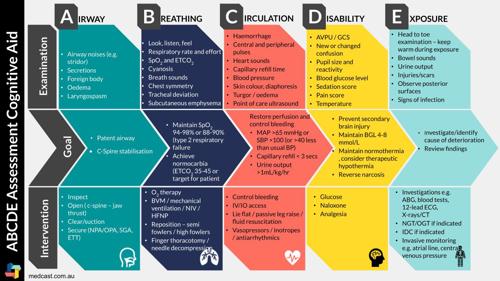Why you should use an ABCDE approach to patient assessment
Why you should use an ABCDE approach to patient assessment
Performing a physical assessment on your patient is like brushing your teeth, should be routine, systematic, thorough and performed at least twice a day. The ABCDE approach is the most recognised tool for rapid patient assessment, it allows us to recognise life-threatening conditions early and provides a systematic method that focuses on fixing problems before moving on, meaning we implement critical interventions in a timely manner.
There’s a lot of information we can obtain just by looking and interacting with the patient.
In stable patients, the ABCDE approach can be performed in the time it takes to put the toothpaste on your toothbrush. Entering a patient’s room and exchanging ‘good mornings’ allows you to establish they have a patent airway (their voice sounded normal), they are breathing normally (able to say good morning and speak in sentences), they have good circulation (colour is normal, they are moving around and alert), they don’t have a neurological deficit (alert and respond appropriately).
ABCDE with deterioration or ED presentation
In the deteriorating patient, or patients presenting in an emergency the ABCDE assessment will take a little longer and should always include a Look, Listen, and Feel approach. The goal of the assessment is to identify and treat any life-threatening conditions, and ensure the delivery of oxygen to vital organs by optimising breathing and circulation. In trauma patients cervical spine immobilisation is included in the A-Airway assessment however airway will take precedence over spinal precautions in the setting of obstructed airway not able to be effectively managed. An example template to follow when performing an ABCDE appears below.

ABCDE in Resuscitation
In a resuscitation setting, the ABCDE assessment tool is useful when establishing initial causes of arrest, and for recapping and prioritising during resuscitation efforts. An initial assessment helps prioritise life-threatening problems that may prevent successful outcomes from resuscitation such as airway obstruction. After rhythm checks it is helpful to recap using the ABCDE approach by checking in with team members e.g.
Airway - "is the airway secure, can you verify we have eTCO2"
Breathing - "is there equal rise and fall of the chest"
Circulation - “are there any signs of bleeding or hypovolaemia”
Disability - “ what’s the patient’s blood glucose level”
Exposure - “ can you check the patient’s temperature”
ABCDE after initial stabilisation or for ongoing care
Once a patient has been stabilised, the ABCDE should be revisited routinely to assess the effects of treatment and confirm patient outcomes are being achieved. At any point during the assessment if a problem is observed or expected response to treatment not achieved then this should be managed before proceeding to the next stage of the assessment.

(Adapted from Peran et.al. 2020)
If you would like to see the ABCDE assessment tool in action and how it applies to the clinically deteriorating patient, register for our upcoming workshop on Recognising and responding to clinical deterioration. This workshop is taking a new approach to learning and will include a range of eLearning, pre-recorded lectures, live or on demand webinars and interactive case studies to provide practical application into clinical practice.
For further information, consider the following courses:
- The ALERT Course (Acute Life-threatening Emergencies Recognition and Treatment)
- PREPARED - Recognising and Responding to Clinical Deterioration
- Lunch and Learn: MET call mayhem
References
Olgers R.., Dijkstra R., Klerck D., Maaten J. (2017) The ABCDE primary assessment in the emergency department in medically ill patients: an observational pilot study. The Netherlands Journal of Medicine Vol 75 (3)
Peran D., Kodet J., Pekara J., Mala L., Truhlar A., Cnorej P., Lauridsen K., Sari F., Sykora R. (2020) ABCDE cognitive aid tool in patient assessment - development and validation in a multicenter pilot simulation study BMC Emergency Medicine 20:95
Resuscitation Council UK (2021) The ABCDE Approach www.resus.org
Thim T., Krarup N., Grove E., Løfgren B. (2021) Initial assessment and treatment with the Airway, Breathing, Circulation, Disability, Exposure (ABCDE) approach International Journal of General Medicine (5) 117-121
World Health Organisation The ABCDE and SAMPLE History Approach Basic Emergency Care Course

Susan is the Head of Nursing Education for the Medcast Group.
DipAppScNsg, BN, CritCareCert, CoronaryCareCert, TraumaNsgCareCert, CertIV(TAE), MN(Ed), and GradCert(Ldrshp & Mgt).
Become a member and get unlimited access to 100s of hours of premium education.
Learn moreWhile cardiac arrest is often a rare event, the high stakes nature means we need to be able to respond instinctively, ensuring immediate effective action when it matters most. How do you stay prepared in-between ALS or PALS courses?
Wayne is a 68-year-old post-CABG patient with third-degree heart block on temporary epicardial pacing who suddenly experiences a bradycardia and hypotension.
The complexity of clinical communication necessitates a shift in resuscitation training. We should challenge terms like "soft skills" and "non-technical skills," and instead refer to them as essential resuscitation skills. A holistic approach that highlights the interconnectedness of these skills is vital for achieving optimal patient outcomes.
